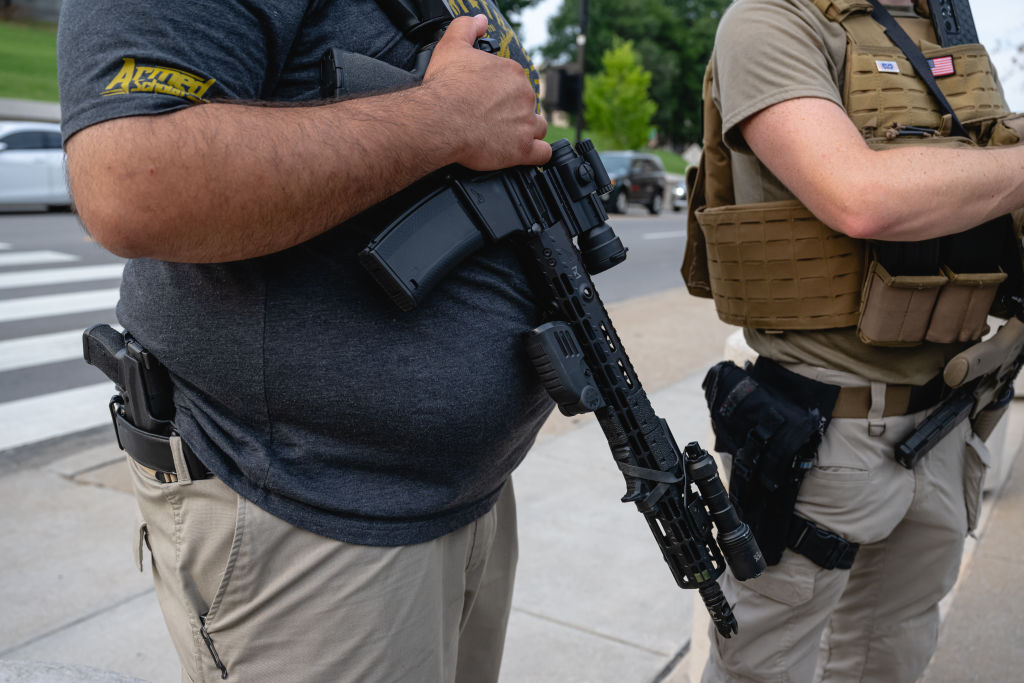
A pro-gun rights demonstrator, armed with an AR-15 and a handgun, stands outside the Tennessee State Capitol in Nashville, August 2023. This image, captured by Jon Cherry/Getty Images, visually represents the ongoing legal battles surrounding assault weapons bans in the United States. These bans have faced increasing challenges in federal courts following the U.S. Supreme Court’s expansion of Second Amendment rights in 2022.
More than two years after the U.S. Supreme Court significantly broadened its interpretation of the Second Amendment, federal courts nationwide continue to overturn state gun control measures. The high court’s 2022 decision in *New York State Rifle & Pistol Association Inc. v. Bruen* established a new standard: firearm regulations must be demonstrably consistent with the nation’s historical tradition of firearm regulation. This historical test has led to several state restrictions being deemed unconstitutional. However, lower courts are still grappling with the specifics of this test, leading to inconsistent rulings on key gun laws.
Despite this ongoing judicial uncertainty, gun rights advocates have achieved notable victories. Federal courts have struck down assault weapons bans in several prominent blue states, including California and Illinois. Specific examples include a federal district court ruling in October that invalidated New York’s ban on concealed firearms on private property open to the public; a September ruling in northern Illinois striking down the state’s ban on concealed firearms on public transit; and a July ruling by the U.S. Court of Appeals for the 8th Circuit upholding the unconstitutionality of Minnesota’s age restriction on public handgun carry.
This wave of legal challenges has kept gun rights attorneys, like Bill Sack (director of legal operations for the Second Amendment Foundation), extremely busy. Sack describes the post-*Bruen* legal landscape as a continuous sprint, with numerous opportunities for new challenges to gun regulations. He and other advocates are now pressing courts to clarify the *Bruen* standard, focusing on three key areas: who can own a firearm, what types of firearms and equipment can be possessed, and where firearms can be carried.
Ongoing court cases are challenging laws that restrict firearm ownership based on age (under 21), nonviolent criminal history, or residency in public housing. Similarly, challenges exist to state restrictions on handguns, assault weapons, high-capacity magazines, and untraceable “ghost guns.” While the Supreme Court has affirmed that states can prohibit firearms in “sensitive places,” the definition of this term remains contentious, leading to ongoing litigation concerning restrictions in locations like mass transit, parks, government buildings, and even polling places (as seen recently in Michigan).
Sack expresses optimism about these legal trends, predicting a historical narrative favorable to gun rights. However, Esther Sanchez-Gomez, litigation director at the Giffords Law Center, offers a more nuanced perspective. She points to recent cases where appeals courts have upheld state bans on assault weapons (such as in Maryland), highlighting the ongoing inconsistency in court rulings. She emphasizes that the issue isn’t definitively settled and that a final consensus remains elusive.
The *Bruen* decision itself stemmed from the Supreme Court’s 6-3 conservative majority overturning a portion of New York’s concealed carry permitting law. The court not only affirmed the right to carry a firearm in public for self-defense but also established the aforementioned historical test for evaluating gun laws. This test requires demonstrating that a regulation aligns with the nation’s historical tradition of firearm regulation, a significant departure from the previous standard set in *District of Columbia v. Heller* (2008).
Justice Clarence Thomas’s majority opinion in *Bruen* outlined this historical test, forcing litigants and lawmakers to find historical precedents for modern gun restrictions. This approach has been criticized by Justice Ketanji Brown Jackson for turning judges into “amateur historians.” Despite this, the Supreme Court has demonstrated a willingness to uphold certain gun restrictions, as evidenced by its 8-1 decision in *United States v. Rahimi* (June 2024), upholding a federal law prohibiting firearm ownership by individuals subject to domestic restraining orders.
Justice Brett Kavanaugh’s concurring opinion in *Rahimi* acknowledged the nascent state of Second Amendment jurisprudence, anticipating numerous future cases. Indeed, The Trace has documented over 1,600 federal court decisions citing *Bruen* as of September 2024, indicating the substantial impact of this ruling. Academic research further supports this observation, although the long-term implications remain uncertain. While some states have seen restrictions overturned, others face ongoing legal challenges.
The determination of appropriate restrictions in “sensitive places” continues to be a major area of contention. Challenges are widespread, encompassing post offices, parks, playgrounds, and other locations. Recent rulings highlight the complex and inconsistent application of these standards across different judicial circuits. The composition of the courts themselves often plays a significant role in the outcome of these cases.
Adam Garber of CeaseFirePA concludes that while the Supreme Court has acknowledged the possibility of some restrictions, the *Bruen* decision presents a significant risk to gun safety legislation due to its interpretation. The legal landscape surrounding gun control in the United States remains fluid and highly contested.

